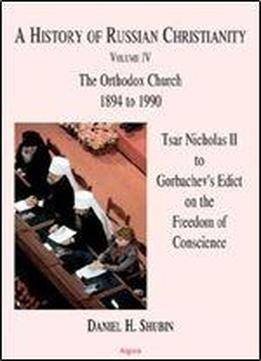
A History Of Russian Christianity, Vol 4
by Daniel H. Shubin /
2017 / Russian / PDF
1.4 MB Download
The events, people and politics that forged the earliest traditions of Russian Christianity are presented objectively and intensively, describing the rise and dominance of the Russian Orthodox Church, the many dissenters and sectarian groups that evolved over the centuries (and their persecution), the presence of Catholicism and the influx of Protestantism and Judaism and other religious denominations into Russia. Derived from primary resources in Church Slavonic and Russian, the history covers the higher levels of ecclesiastical activity including the involvement of tsars and princes, as well as saints and serfs, and monks and mystics.
Vol. I: From the Earliest Years through Ivan IV deals with the period from Apostle Andrew to the death of Tsar Ivan the Terrible, just prior to the election of the first Russian Patriarch, a period of almost 1600 years.
Volume II The Patriarchal Age Through Tsar Peter The Great, 1586 to 1725 covers the Patriarchal Era through the reign of the great reformer, Tsar Peter I, and the eventual institution of the synodal system as a replacement for the Patriarchate.
Volume III The Synodal Era and the Sectarians, 1725 to 1894 covers the period 1725 through 1894, which is known as the Synodal Era of Russian Orthodoxy. This is the era of Empresses Elizabeth and Catherine the Great, and the great tsars of 19th-century Russia. The Synodal Era includes the rise of the dissenters and sectarians. The history of Old Believers is discussed, along with the Iconoclasts, Judaizers, Dukhabors, Molokans, Khlisti, Skoptzi, and Stundists of Russian Christianity, and the many other small sects, as well as the Christian philosophies of Grigori Skovoroda and Leo Tolstoy.
In Volume IV, The Orthodox Church 1894 to 1990 Tsar Nicholas II to Gorbachev's Edict on the Freedom of Conscience, the initial chapters cover the decline of the power of Russian Orthodoxy, the rise of Rasputin, and the last tsar Nicholas II then the struggle of Russian Orthodox Christianity to survive as the Russian Empire falls to the Soviets is discussed. The balance of the volume deals with the dramatic era of the Soviet regime's efforts to bring down Russian Orthodoxy, ending with the reversal under Gorbachev in 1990 and the Church's resurgence.
It is difficult to write solely a history of the Russian Orthodox Church, because the history of Russia as a state, people and culture is completely interwoven with their religion and every event, person and location has a religious association. And two other problems are present. The first is the meager information available on the period prior to AD 1240, when major cities, churches and monasteries of Russia were utterly destroyed by Mongol invaders for the next 240 years, Russia was under Mongol occupation. The second problem is credibility: Russian Orthodoxy has rewritten its history over the years, beginning with the mid-14th century, incorporating much improbable embellishment. Fiction and legend must be removed in order to present an objective account.
This series of the Christianity of Russia will become a staple for students and scholars of Russian history and Russian Orthodoxy and will serve as a fundamental text for college courses in Russian history and for seminaries in Russian and Orthodox religion.











